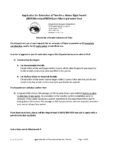Oregon Extensions of Time Receive Increased Scrutiny

Do you remember when extensions of time were approved by the Oregon Water Resources Department routinely with ease? That time was over for municipal water providers years ago (see related article); however, until recently, other permit holders simply faced increasing amounts of application paperwork. Now, that time may be over for every permit holder. Our office has seen requests for extensions of time receive increased scrutiny from the Department as of late.
Recently, a client applied for their first extension of time after investing substantial resources towards diligent development under their water use permit. The proposed final order approving the extension of time was 13 pages long, discussing every single inquiry from the extension application and whether the client’s response was sufficient. Even though the Department is proposing approval, it is clear that such approval will be more difficult to receive going forward.
Certain factors are of extreme importance for water users hoping to obtain extensions of time for their water use permits. Physical construction must begin and be diligently prosecuted during the time to complete construction under the permit or prior extension period. The Department will closely examine how much physical development of the water system has occurred and the permitee’s reasons for not completing construction. The Department will also evaluate and balance financial investment, market and present demands for water, the amount of water available to satisfy other affected water use rights, scenic waterway flows, and habitat needs of sensitive, threatened or endangered species.
Of additional importance is compliance with permit conditions. If a groundwater use permit requires annual static water level measurements following well construction, it is extremely important that the permittee complies with the condition. The same is true for installation of flow meters, submission of water use reports, and more. The Department may deny an application for extension of time for less than full compliance with all permit terms.
Applications for extensions of time have increased in length and complexity over the years. The current permit extension application is 12 pages long. (Extension of time application forms are available here.) Our office routinely completes extension of time applications for clients. It takes time to provide all the development details and documentation now required by the Department. Do not wait until the day before your permit expires to start your extension application. We recommend seeking assistance one year before your permit or current extension term expires to consider if an extension can be avoided, and, if not, making sure all conditions are met before an extension of time application is filed.
It is more important now than ever to make sure you have all your “ducks in a row” when using water under a permit and seeking an extension of time. Stay tuned to Schroeder Law Office’s Water Law Blog for more news that may affect you!


































